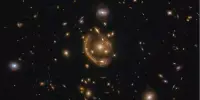Gravity is a well-established principle in physics that has been extensively studied and tested, and the current consensus among scientists is that the theory of general relativity, put forth by Albert Einstein in 1915, provides the most accurate explanation of gravity. However, it’s always possible that new data or research could challenge current understanding and lead to the development of new theories.
The vast majority of galaxies, according to the standard cosmological model, are surrounded by a halo of dark matter particles. This halo is invisible, but its mass exerts a strong gravitational pull on nearby galaxies. A new study calls this view of the Universe into question. The findings imply that the dwarf galaxies of Earth’s second closest galaxy cluster, the Fornax Cluster, are devoid of such dark matter halos.
Dwarf galaxies are small, faint galaxies found in galaxy clusters or near larger galaxies. As a result, they may be influenced by the gravitational effects of their larger companions. “We introduce an innovative way of testing the standard model based on how much dwarf galaxies are disturbed by gravitational tides’ from nearby larger galaxies,” said Elena Asencio, the story’s lead author and a PhD student at the University of Bonn. Tides form when gravity from one body pulls on different parts of another body in different ways. These are similar to tides on Earth, which form when the moon exerts a stronger pull on the side of the Earth that faces the moon.
The Fornax Cluster has a rich population of dwarf galaxies. Recent observations show that some of these dwarfs appear distorted, as if they have been perturbed by the cluster environment. “Such perturbations in the Fornax dwarfs are not expected according to the Standard Model,” said Pavel Kroupa, Professor at the University of Bonn and Charles University in Prague. “This is because, according to the standard model, the dark matter halos of these dwarfs should partly shield them from tides raised by the cluster.”
Our findings have far-reaching implications for fundamental physics. We anticipate finding more disturbed dwarfs in other clusters, which other teams should confirm.
Dr. Hongsheng Zhao
The authors investigated the expected level of disturbance of the dwarfs, which is determined by their internal properties and distance from the gravitationally powerful cluster center. Large galaxies with low stellar masses, as well as galaxies near the cluster center, are more easily disturbed or destroyed. They compared the results to the level of disturbance seen in photographs taken by the European Southern Observatory’s VLT Survey Telescope.
“The comparison showed that, if one wants to explain the observations in the standard model” – said Elena Asencio – “the Fornax dwarfs should already be destroyed by gravity from the cluster center even when the tides it raises on a dwarf are sixty-four times weaker than the dwarf’s own self-gravity.” Not only is this counter-intuitive, she said, it also contradicts previous studies, which found that the external force needed to disturb a dwarf galaxy is about the same as the dwarf’s self-gravity.

Contradiction to the standard model
From this, the authors concluded that, in the standard model, it is not possible to explain the observed morphologies of the Fornax dwarfs in a self-consistent way. They repeated the analysis using Milgromian dynamics (MOND). Instead of assuming dark matter halos surrounding galaxies, the MOND theory proposes a correction to Newtonian dynamics by which gravity experiences a boost in the regime of low accelerations.
“We were not sure that the dwarf galaxies would be able to survive the extreme environment of a galaxy cluster in MOND, due to the absence of protective dark matter halos in this model,” said Dr. Indranil Banik of the University of St Andrews, “but our results show a remarkable agreement between observations and MOND expectations for the level of disturbance of the Fornax dwarfs.”
“It’s exciting to see that the data we obtained with the VLT survey telescope allowed such a thorough test of cosmological models,” said co-authors Aku Venhola of the University of Oulu (Finland) and Steffen Mieske of the European Southern Observatory.
This isn’t the first time that a study looking at the effect of dark matter on the dynamics and evolution of galaxies has concluded that observations are better explained when they aren’t surrounded by dark matter. “Every year, the number of publications demonstrating incompatibilities between observations and the dark matter paradigm grows. “It’s time to start putting more money into more promising theories,” said Pavel Kroupa, a member of the Transdisciplinary Research Areas “Modeling” and “Matter.” “at Bonn University.
The University of St Andrews’ Dr. Hongsheng Zhao added: “Our findings have far-reaching implications for fundamental physics. We anticipate finding more disturbed dwarfs in other clusters, which other teams should confirm.”
















